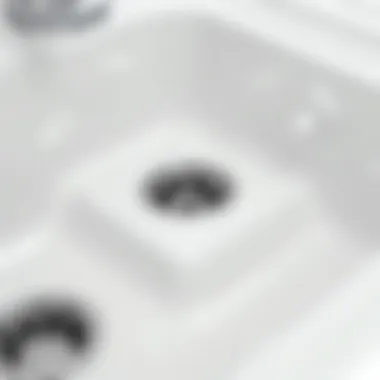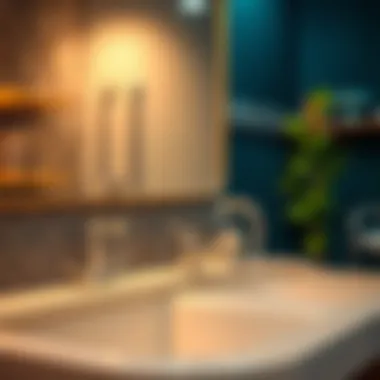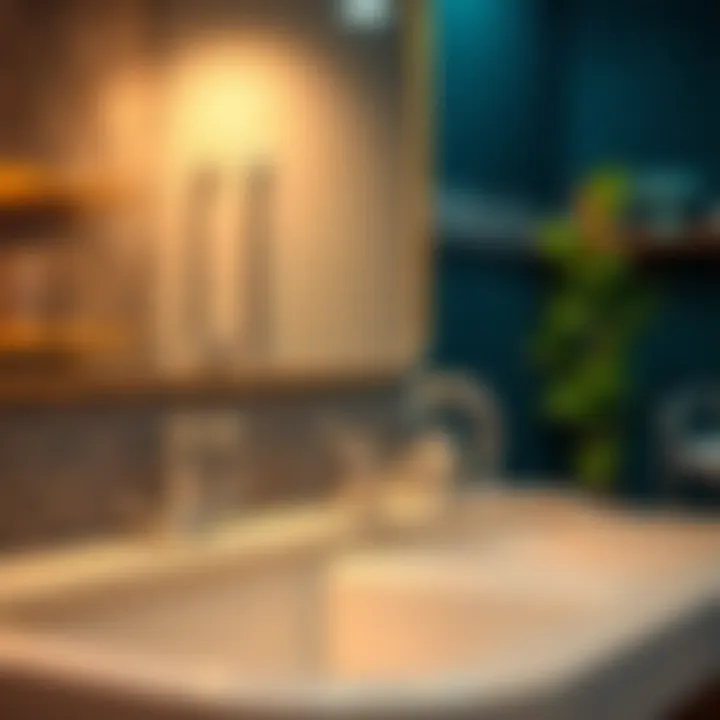Mastering Dual Sink Drain Plumbing: A Complete Guide


Intro
In the world of modern kitchens and bathrooms, dual sink drain plumbing stands out as not only a functional necessity but also an aesthetic choice. The decision to opt for a dual sink setup often stems from the desire for increased efficiency and convenience, particularly in busy households. Homeowners and professionals alike seek to understand the nuances involved in designing, installing, and maintaining such systems.
Consider this: two sinks mean double the functionality and a significant upgrade in usability. Imagine preparing meals or handling morning routines without stepping on each other’s toes. Yet, behind the appealing exterior lies a complex interplay of plumbing mechanics that, if misunderstood, can lead to irritating clogs and costly repairs.
This guide aims to simplify those complexities, presenting insights on the essential considerations for successful installations and effective maintenance. Whether you’re a seasoned contractor or a homeowner eager to dive into your next home improvement project, this narrative addresses the core elements of dual sink drain plumbing—from layout and materials to troubleshooting common issues.
In exploring each topic cohesively, we will emphasize practical knowledge that enhances your plumbing expertise and equips you to approach installations confidently. With this guide in hand, your understanding of dual sink systems will not only support practical applications but also encourage an appreciation for the elegance of thoughtful plumbing design.
Preamble to Dual Sink Drain Plumbing
Dual sinks are becoming increasingly common in many modern homes, especially in kitchens and bathrooms. They not only add a touch of elegance but also enhance functionality. When one sink is being used, the other can accommodate other tasks, making daily chores more efficient. In the context of dual sink drain plumbing, understanding the intricacies of installing and maintaining these systems can significantly impact the overall plumbing performance in a home. Knowing how dual sink drain systems are structured can help homeowners make informed decisions, whether it's a new installation or troubleshooting an existing setup.
The Necessity of Dual Sinks
Let's face it: the hustle and bustle of everyday life rarely allows us to stand idly by. This is where dual sinks step in. Imagine washing dishes in one basin while rinsing vegetables in the other. It saves time and allows for multitasking, particularly useful in households with busy routines. Moreover, if you’re entertaining guests, having two sinks lets you keep your cooking area organized and tidy.
Another reason dual sinks can be vital is their impact on home value. A well-thought-out bathroom or kitchen design featuring dual sinks can be a hot selling point. Many buyers are now looking for homes with such functional features, driving a market trend toward homes equipped with these systems.
Overview of Plumbing Systems for Dual Sinks
An efficient plumbing system for dual sinks involves several components working together seamlessly. Think of it as an orchestra; each instrument contributes to a harmonious result. Typically, these systems incorporate two drains converging into a common drain line. This ensures that both sinks can operate independently without hindering each other's performance.
Key components include:
- P-Traps: Essential for preventing smells from rising up through the drain. Each sink should have its own P-Trap, but they can also share one if designed correctly.
- Vent Pipes: These aid in maintaining proper air pressure in the drainage system, allowing water to flow smoothly. Neglecting vents could lead to slow drainage or even backflow issues.
- Drain Pipes: Materials like PVC or copper can be used based on budget and personal preference. Each material has its pros and cons, particularly in durability and aesthetics.
"Understanding how each component works together can help alleviate many common plumbing headaches down the line."
Taking the time to understand your dual sink plumbing system today can pay dividends later. Investing in quality components and thoughtful design makes future repairs simpler and keeps your sinks flowing like a charm.
Understanding Drainage Principles
Understanding drainage principles is crucial when dealing with dual sink drain plumbing. This knowledge not only helps you effectively manage the plumbing system but also ensures functionality and longevity. Plumbing systems are a balancing act of gravity, pressure, and flow, all of which play pivotal roles in the efficient management of water flow and waste movement.
Gravity and Drainage Flow
Gravity is the unsung hero of your plumbing system, working behind the scenes to ensure that water travels from high points to low ones without any fuss. In a dual sink setup, each sink should be positioned to allow gravity to aid the drainage process. The ideal layout ensures that the sink drains connect seamlessly to the main drain line, sloping downward at a consistent angle.
When installing dual sinks, aim for a minimum slope of one-quarter inch per foot. This approach enhances drainage efficiency and reduces the likelihood of backups. An improper slope might lead to water not fully draining away, resulting in lingering puddles and potential odor issues.
In order to visualize how gravity affects drainage, consider a water slide at a theme park; its angle determines the speed and effectiveness of the water flow. Likewise, your drain pipes need that same strategic angle to keep the plumbing free and clear.
Remember, effective drainage is about balance; too steep, and you'll face splashing; too shallow, and you risk clogs.
Siphon Effect in Drain Systems
The siphon effect occurs when water moves through a pipe due to a pressure difference that creates a vacuum. In the context of a dual sink drain setup, it plays a vital role in maintaining smooth flow and preventing unpleasant odors from wafting up through the drains.
One common source of siphoning trouble comes from vent pipes, which are essential to allowing air to enter the plumbing system as water drains. Without proper venting, a siphoning effect might inadvertently create negative pressure in the drain line, causing slow drainage and backups. Without adequate venting, you're bound to frustrate yourself with all sorts of blockages.
Here’s how to ensure the siphon effect works in your favor:
- Ensure Proper Venting: Install vent pipes correctly to keep that air flowing and prevent vacuums from forming.
- Regular Maintenance: Keep an eye on the vent pipes for any obstructions; a clean path ensures the siphon can do its job.
- Monitor Water Levels: If you notice inconsistent water levels in the sinks, it may signal siphon issues or venting problems.
The interplay of gravity and the siphon effect is what truly defines the quality of your drainage system. Recognizing these principles equips homeowners and professionals alike to avoid common pitfalls related to dual sink installations, ensuring a more reliable and efficient plumbing system.


Components of Dual Sink Drain Plumbing
When undertaking the installation or maintenance of a dual sink system, understanding the components involved is crucial. Each part plays a significant role in ensuring that everything runs smoothly and efficiently. Not only does this knowledge help in troubleshooting, but it also allows for better planning and execution during installation.
The main components that make up dual sink drain plumbing are the P-traps, drain pipes, and connecting fittings. Each of these elements comes with certain specifications and options that will suit different setups and needs. Neglecting any of these components can lead to ineffective drainage or worse—water damage and clogs. By employing the right materials and maintaining these components, homeowners can extend the longevity and performance of their sink systems.
P-Traps: Function and Maintenance
P-traps are integral to any plumbing system, particularly in dual sinks. These curved pipes are specifically designed to hold a small amount of water at all times. This trapped water acts as a barrier, preventing sewer gases from entering your home.
Understanding how to maintain a P-trap is equally important. Over time, they can become clogged due to accumulated food particles, grease, or hair. Regularly inspecting these traps can help to avoid troublesome backflows. Homeowners should consider the following for effective maintenance:
- Visual Inspection: Every few months, take a look beneath the sink to see if there's any noticeable debris or wear on the P-trap.
- Cleaning: Use a mixture of vinegar and baking soda to naturally dissolve any buildup in the trap.
- Replacement: If a P-trap is corroded or damaged, replacing it should be a priority. Neglecting this can lead to leaks and associated water damage.
By ensuring your P-traps are working as they should, you can significantly impact the overall efficiency and cleanliness of your dual sink plumbing.
Drain Pipes: Materials and Options
The type of drain pipes you choose can make or break your dual sink installation. Common materials for drain pipes include PVC, ABS, and metal options like copper and cast iron. Each material comes with its own set of benefits:
- PVC (Polyvinyl Chloride): Lightweight and resistant to corrosion, PVC is popular for its ease of installation and affordability. However, it can be less durable than metal options in extreme temperatures.
- ABS (Acrylonitrile Butadiene Styrene): Known for its strength and impact resistance, ABS works well in colder climates. It’s also easy to install but may be priced slightly higher than PVC.
- Copper: Though more expensive, copper pipes are durable and can resist bacteria growth. Their longevity is often worth the initial investment.
- Cast Iron: This heavy-duty material provides excellent sound insulation, making it ideal for installations in multi-story buildings, though it is prone to rust and corrosion over time.
When selecting your drain pipes, consider factors such as local plumbing codes, budget, and the specific requirements of your sink system. Proper installation of these pipes is vital to prevent leaks and ensure optimal drainage performance.
Connecting Fittings: Types and Uses
The connecting fittings used in a dual sink drain system serve as the glue that holds everything together. Several types of fittings ensure that water flows seamlessly from the sinks to the plumbing system:
- Elbows: These fittings allow for directional changes in piping, essential when maneuvering around obstacles.
- Tees: When connecting additional drains, tees help create branched lines effectively.
- Adapters: Needed for joining dissimilar pipe materials, adapters ensure a tight fit and proper flow.
The right fittings can simplify your plumbing layout and even offer some flexibility for future alterations. Choosing durable and appropriate fittings for your specific system can lead to a significant decrease in potential leaks and maintenance needs. Furthermore, do not forget to tighten connections adequately to avoid future problems!
"The best plumbing systems are those that are well understood and maintained. Knowledge of components is key to avoiding troubles down the road."
For additional resources, you might consider visiting Wikipedia on Plumbing or consulting the Plumbing-Heating-Cooling Contractors Association for professional guidance.
Installation Process for Dual Sink Drain Systems
The installation of a dual sink drain system is critical in both ensuring efficiency and preventing future plumbing mishaps. This process can sculpt the difference between a flawless and chaotic kitchen or bathroom setup. Knowing the ins and outs of dual sink installations empowers homeowners and professionals alike, providing them with the confidence to tackle potential challenges head-on. With dual sinks becoming a staple in modern homes, grasping the installation process allows for an enhanced functionality of plumbing systems that can handle larger demands.
Pre-Installation Considerations
Before diving into the installation process, several key considerations must be taken into account. Understanding these factors can save time, money, and a truckload of headaches down the line. First off, you must confirm the sink size and configuration. Each layout offers unique plumbing requirements, so measuring the space accurately becomes paramount.
Tip: Ensure to pay heed to the plumbing codes in your area. Familiarizing yourself with local regulations is crucial; you wouldn’t want to cut corners during installation only to face regulatory fines or, worse, unsafe plumbing.
Additional considerations include:
- Water Supply Access: Is your existing plumbing ready for a dual setup?
- Ventilation Issues: Proper venting is vital; this will help to avoid siphoning problems that can cause slow drainage.
- Room Layout: Will you have enough space around the sinks for daily usage?
Taking the time to address these pre-installation considerations can lead to a smoother installation experience.
Step-by-Step Installation Guide
Following a systematic approach can streamline the installation of a dual sink drain system. Here’s a comprehensive guide:
Setting Up the Sink Layout
The layout of the sinks plays a crucial role in the effectiveness of the plumbing system. The design should prioritize functionality whilst allowing enough room for everyday activities. A centered sink layout is often a popular choice as it creates symmetry and maximizes usage efficiency. Moreover, this configuration generally facilitates easier plumbing connections and maintenance.


Unique features of a centered arrangement include:
- Reduced Plumbing Complexity: Fewer angles or connections means less room for leaks and other plumbing woes.
- Balance in Workflow: A well-structured design promotes better movement, making cleaning and washing more convenient.
Advantages of this design form encompass space optimization. Conversely, a poorly thought-out layout can lead to awkward usage experiences and potential plumbing challenges — something no homeowner wishes to confront.
Installing P-Traps and Drain Pipes
The installation of P-Traps and drain pipes is the heart of the plumbing operation for dual sinks. P-Traps are designed to hold water, serving as a barrier against sewer gases, while enabling smooth waste disposal. Not only that, but they also protect against clogs from creating a perfect storm in your plumbing systems by maintaining a water seal.
Key characteristics are:
- Effective Odor Control: By trapping water, they ensure harmful gases don’t escape into your home environment.
- Easier Clog Management: When a blockage arises, access to P-Traps simplifies the clearance process.
While useful, keep in mind that improper installation can lead to leaks, which may cause damage or unintended flooding. Thus, double-check your connections and ensure a snug fit.
Connecting the Water Supply Lines
Lastly, connecting the water supply lines may seem trivial, yet it is paramount to an effective sink installation. These lines facilitate the flow of fresh water to your dual sinks, allowing for seamless functionality.
A couple of characteristics to note include:
- Material Selection: Choosing high-quality materials like copper or flexible plastic can enhance durability.
- Ease of Repairs: If a line begins to leak, having accessible and well-placed connections can simplify future fixes.
Ensuring the right connections can prevent water pressure issues that may arise from poorly executed linkages. Additionally, double-checking your fittings before sealing them off may save a world of trouble in cases of unexpected leaks.
In summary, a meticulously planned installation process paves the way for well-functioning dual sink systems. Addressing pre-installation factors, carefully laying out sinks, and expertly installing the plumbing components can transform how a space operates and enhances livability.
Common Issues and Troubleshooting
Dealing with dual sink drain plumbing can be a smooth ride, but it can also bring about some bumps along the way. Understanding common problems and how to troubleshoot them is key to ensuring everything flows as it should. Knowing what issues can occur allows homeowners and professionals alike to maintain the functionality of their systems and sidestep costly repairs. If you’ve been in the game long enough—or even if you’re just starting out—you know that being aware of possible hiccups makes for a hassle-free experience.
Clogs and Blockages
Identifying the Cause
Clogs can be elusive and maddening, often catching you off guard at the most inconvenient times. To effectively tackle blockages, pinpointing the cause is crucial. Solid food debris, grease build-up, and hair can all wreak havoc on your drain pipes. It’s essential to know that the first sign of a problem often materializes as slow drainage or perhaps even gurgling sounds from the sink.
A distinctive characteristic of identifying the cause lies in recognizing that not all clogs are created equal. Each type of blockage may require a different approach for resolution. For instance, if there’s accumulated grease, hot water might do the trick. This knowledge empowers you to act swiftly, rather than playing a guessing game—saving time and reducing frustration. Detecting the right issue from the get-go fosters a more effective resolution and potentially less money down the drain.
Methods for Clearing Clogs
Once you’ve identified the trouble spot, the next step is to clear the blockage. Methods for clearing clogs often range from manual tools to chemical solutions. Simple methods include using a plunger or a plumber’s snake, which can often do wonders when it comes to removing debris. On the chemical side, drain cleaners can be a viable option but must be used with caution. The important thing here is flexibility in approach; sometimes, the simplest method is often the quickest.
A notable benefit of these methods is that they can be utilized with minimal tools and experience. However, over-reliance on chemical drain cleaners poses environmental risks and can potentially damage pipes if not used correctly. Thus, it's wise to always consider the long-term impacts of any chosen method.
Leaks and Water Damage
Detecting Leaks
Leaks can be the silent offenders in plumbing issues. They often begin subtly, with a small trickle or damp area under the sink, but can lead to significant water damage if left unchecked. Detecting leaks involves keen observation for signs such as water stains on cabinets, unexpected increases in water bills, or mold growth. The unique feature of addressing leaks is knowing when to conduct periodic checks—especially in older homes where plumbing might be aging.
Proper leak detection is invaluable as it directly connects to property preservation and maintenance. Addressing a small leak can prevent a cascade of related issues, ranging from structural damage to health risks from mold. Hence, being proactive here is not just about fixing a leak but protecting your home’s integrity.
Repair Techniques and Preventative Measures
When it comes to rectifying leaks, having effective repair techniques and preventative measures at your disposal is essential. This can range from tightening loose fittings to replacing worn-out seals in joints. Prevention goes hand in hand here—incorporating routine inspections to look for wear and tear can often keep problems at bay.


One of the standout features of these repair techniques is that they often require basic tools and can be performed by the average homeowner. However, if the leakage problem is widespread or involves complex piping systems, calling in a professional may save a lot of hassle in the long run.
In summary, knowing how to troubleshoot common issues like clogs and leaks not only saves time but also money. With an eye for detail and a willingness to act, any homeowner can tackle the intricacies of dual sink drain plumbing with confidence.
Maintenance Recommendations
Maintenance for dual sink drain plumbing is not just a chore; it’s a critical component to ensuring your system runs smoothly over the long haul. Ignoring the maintenance aspects can lead to a host of issues down the line, including leaks, clogs, and even costly repairs. It’s a bit like keeping your car in good shape — regular checks can save you from a breakdown when you least expect it.
Routine Cleaning Practices
Regularly cleaning your dual sinks is paramount in maintaining a hassle-free plumbing experience. Think of it as tidying up after your kids — if you don’t stay on top of it, things can get messy quickly. Here are some essential steps for routine cleaning:
- Remove Debris: Start by clearing out any food or substance that may have accumulated in the drain. A simple mesh strainer can save you a headache by preventing larger particles from traveling too far into the plumbing.
- Use Hot Water: Running hot water through your sinks on a weekly basis helps dissolve any grease or grime build-up. Just like a warm shower for your plumbing!
- Natural Cleaners: Occasionally, use a baking soda and vinegar mixture to freshen things up. Pour half a cup of baking soda down the drain, followed by a cup of vinegar. Let it sit for about 30 minutes, then flush with hot water. It’s a simple yet effective trick — just ensure you’re not using commercial cleaners in tandem, as some can cause reactions.
- Regular Inspection: Every month, take 10 minutes to check for any visible debris. That way, you can catch small issues before they snowball into larger problems.
"An ounce of prevention is worth a pound of cure."
Inspecting Connections and Seals
Taking a closer look at your connections and seals is another critical aspect of maintenance. Just like checking your home’s roof or windows, ensuring everything is tightly sealed can prevent leaks that may go undetected for some time. Here’s how to tackle this:
- Visual Checks: Every few months, pull out the flashlight and inspect the plumbing beneath your sink. Look for any signs of water staining, corrosion, or any visible drop in the connections.
- Tighten Fittings: Use a wrench to gently tighten any loose fittings. But you have to be careful – over-tightening can cause cracks or damage, much like cranking down on a jar lid too hard.
- Evaluate Seals: Check the rubber gaskets and seals around your P-traps and drain pipes. If you notice any cracking or deformation, it’s best to replace them. A small, relatively inexpensive fix can save you from a bigger disaster.
- Professional Inspection: If you are unsure, or things seem to be amiss, don’t hesitate to call in a professional. Sometimes a second set of eyes is worth its weight in gold.
Design Considerations for Dual Sinks
Designing a dual sink setup is not just about slapping two basins together and calling it a day. The planning and execution really need careful thought to ensure a seamless blend of style and utility. The importance of focusing on design considerations cannot be overstated. Every little detail impacts your daily use and overall satisfaction with the space.
When you think about dual sinks, it’s crucial to consider several aspects: the layout, size, and style of the sinks. Each of these elements can significantly influence how efficiently the sinks function and how they fit within the larger context of your bathroom or kitchen design. For instance, if you have a large space, opting for two larger sinks can be beneficial. But if space is tight, you might want to look into more compact models or even undermount sinks.
Another vital consideration is the plumbing configuration. Ensure that the plumbing lines are properly planned out to avoid clogs or leaks that can arise from improper adjustments. Additionally, having a good drainage slope is essential; pipes should have a downward pitch to encourage optimal flow. Ultimately, the effectiveness of your dual sink setup hinges on thoughtful design that prioritizes both functionality and aesthetics.
"A well-designed dual sink isn't just about looking good; it's about working harmoniously with your daily routines."
Choosing the Right Sink Configuration
Choosing the right sink configuration is like deciding on the right shoes for a long trek; it’s all about functionality mixed with personal preference. There are several configurations to consider, such as side-by-side, which offers ample space for multitasking, or a staggered setup that may save on plumbing complexity.
You should also consider the depth and bowl size. For instance, if you’re often washing big pots and pans, opting for deeper bowls could save you from splashes and mess. Conversely, shallower sinks might be better if you frequently clean delicate items, preventing them from being submerged too deep. Additionally, materials matter; porcelain, stainless steel, and even composite options each have unique pros and cons. It could be wise to explore these materials based on your specific needs and how they withstand the daily grind.
Aesthetics vs. Functionality
Navigating the balance of aesthetics and functionality can feel like walking a tightrope. On one side, you have the desire for an attractive and modern look, while on the other, you need practicality in your daily tasks. It can be tempting to go for a purely stylish well-designed sink, but if it lacks in practicality—think how easy it is to clean or how it handles water stains—your initial satisfaction might dwindle over time.
Designing with an eye for both can yield elegance without sacrificing usability. For instance, consider sleek, minimalist faucets that complement your high-end sink while being easy to operate. Look into finishes that not only catch the eye but also resist scratches and marks. Choosing complementary accessories like soap dispensers or sink grids can also enhance the visual appeal while maintaining function.
Ultimately, aesthetics and functionality should go hand-in-hand. An eye-catching setup should perform well to deliver you satisfaction without the headache. This approach guarantees that you not only enjoy your dual sink visually, but also appreciate how they enhance your workflow and day-to-day living.
Epilogue
The significance of dual sink drain plumbing cannot be overstated, especially when it comes to modern kitchens and bathrooms. As lifestyle preferences shift toward functionality and convenience, these plumbing systems become indispensable. They not only enhance usability by accommodating multiple users simultaneously but also contribute to an aesthetically pleasing setup. The design allows for quicker meal preparation and efficient cleaning routines, catering to both everyday needs and special occasions.
Recap of Key Points
Throughout this guide, we explored various facets of dual sink drain plumbing, including:
- The necessity and design of dual sinks in contemporary settings.
- Fundamental drainage principles that ensure an effective plumbing system.
- The essential components, from P-traps to drain pipes, and how they work together.
- The detailed installation process, emphasizing preparation and execution challenges.
- Common issues like clogs and leaks, along with troubleshooting strategies and maintenance tips.
- Thoughtful design considerations that balance functionality and aesthetics in choosing sinks.
With this information, homeowners and professionals are equipped with the knowledge needed to navigate the complexities of dual sink plumbing effectively.
Final Thoughts on Dual Sink Drain Plumbing
Embracing dual sink drain systems offers numerous advantages, making it a valuable investment for any home. By understanding both the technical aspects and the design elements, one can make informed decisions. It’s imperative to approach installation and maintenance with care, ensuring that the entire system operates seamlessly.
"Understanding your plumbing isn't just a technical necessity; it's a pathway to enhancing your home's functionality and value."
For further reading on related topics, consider checking resources like Wikipedia or Britannica. Additionally, online forums like Reddit can offer real-life insights and experiences shared by other homeowners.















